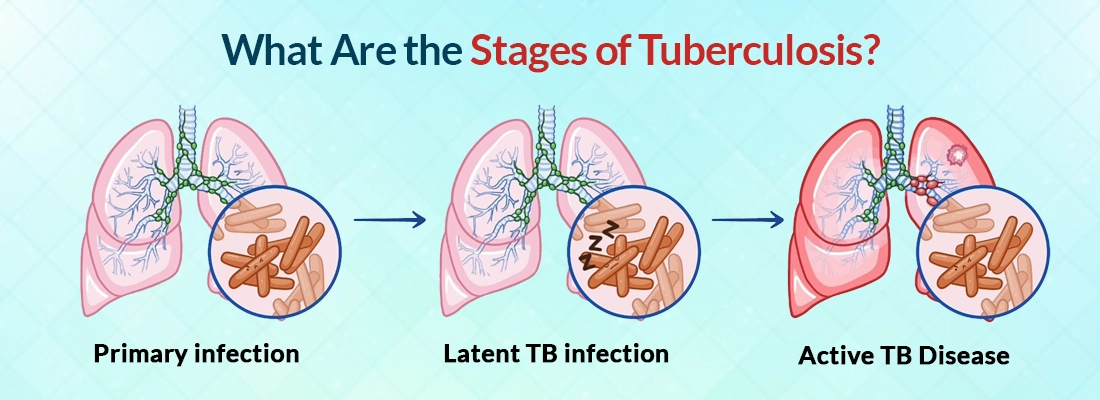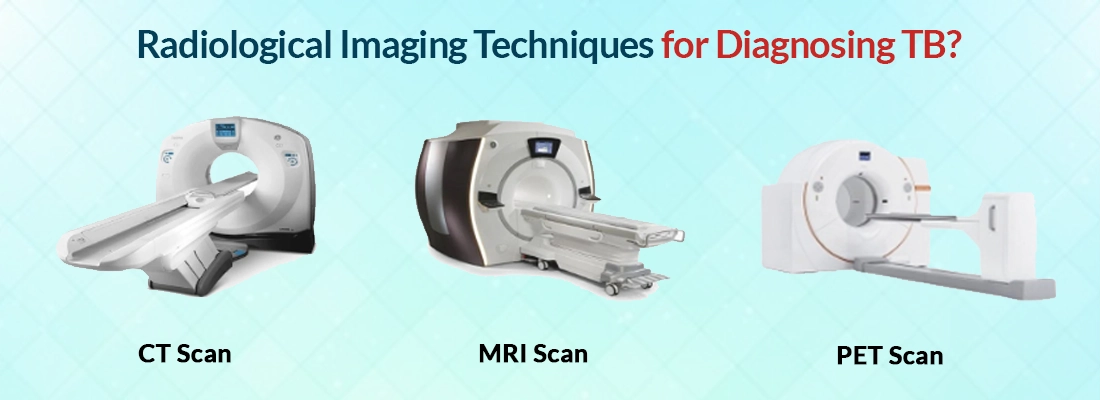
By the medium of this blog, we will learn about what Tuberculosis is, what are its symptoms and signs and how the doctor confirms its presence by Ct scan and other tests.
Tuberculosis acronym TB is an infectious disease caused by the bacteria Mycobacterium Tuberculosis. TB can affect any part of the body including lungs being most common and the brain, spine, kidney and other organs. TB can be fatal if it is not treated correctly. Hence TB needs to be diagnosed at an early stage and treated Correctly. There are various methods to diagnose TB such as the CT or CAT Scan, MRI Scan, PET Scan, Blood tests, etc.
What Are the Stages of TB?

TB does not necessarily manifest in the body and give symptoms, some TB types remain dormant in the system known as Latent TB. TB is usually classified into 3 stages
- Primary infection
- Latent TB infection
- Active TB Disease
- In lungs/intrapulmonary
- Outside the lungs/extrapulmonary
What Are the Symptoms of TB?
TB spreads and multiplies in lungs, it can represent different symptoms in different stages
Primary TB Infection
It is the first stage of TB infection.during a primary stage people may have symptoms like
Latent TB Infection
There are no symptoms seen in the latent phase as the name itself states, TB remains dormant in this stage. The immune cells build a wall around the TB infectious cells and the TB is unable to manifest its symptoms.
Active TB Disease
The disease manifests when the immune system is unable to control its spread. The active disease can happen right after the primary infestation of the
Intrapulmonary Active TB
TB but it usually appears after a few months of the infection. Symptoms of an active TB represent in the lungs but can spread further, they include-
- Cough
- Coughing up mucus and blood
- Chest pain
- Pain while coughing and breathing
- Fever
- Chills
- Night sweats
- Severe weight loss
- Tiredness
- Not wanting to eat
- Not feeling well in general
Extrapulmonary Active TB
TB infection can spread outside of the lungs to manifest itself in other parts of the body. This is known as extrapulmonary TB. common symptoms are-
- Fever
- Chills
- Night sweats
- Weight loss
- Not wanting to eat
- Tiredness
- Not feeling well in general
- Pain Near the site of infection
Sites Where TB Can Manifest?
- Kidney
- Liver
- Heart muscles
- Genitals
- Lymph nodes
- Bones and joints
- Skin
- Walls of blood vessels
- Voice box known as larynx
- Fluid surrounding the brain and spinal cord
- genitals
Radiological Imaging Techniques for Diagnosing TB?

Intrapulmonary and extrapulmonary Tuberculosis can be diagnosed by blood and sputum analysis, also some radiologic approach helps confirming the diagnosis of TB such as-
- Chest X ray- helps in diagnosing pulmonary TB
- CT scan
- PET scan
- MRI scan
- Ultrasound
PET scan, CT scan and MRI scan helps in diagnosis of both pulmonary and extrapulmonary Tuberculosis.
Other Tests for Diagnosis of TB
Physical Analysis
- Listening to your breath using a stethoscope
- Checking swollen lymph nodes
- Taking your history of symptoms
TB Tests
- Skin test
- Blood test
- Sputum tests
- Other lab tests include- breath test, urine test, CSF fluid analysis test.
- PCR test
- Bronchoscopy
What to Prepare for a Lung CT?
For a CT scan there are certain precautions and cautions that need to be taken care of, some of them are mentioned below
- Precautions- if you think you are pregnant or are pregnant, you should inform your doctor and the healthcare provider beforehand only, as the CT scan uses ionising radiation which can be harmful for your unborn baby.
- Clothing- you need to wear loose comfortable clothes, your clothes should not be embroidered or they shouldn't have any embellishment as well as they might alter the scan report and hence affect diagnosis and treatment plan further. You might be asked to change your clothes and wear a patient gown instead. You need to remove ay jewellery or metal items if you have, and inform about and metallic medical device such as a cardiac pacemaker to your doctor
- Contrast medium- CT scans use contrast dye known as contrast CT scan which helps improve the scan image quality, hereby aid in diagnosis and treatment planning. You would be asked to sign a consent form which says all the risks and possible side effects of the contrast dye and that you are comfortable with all.
- Eat/Drink- if you are ordered an NCCT-Non Contrast Computerised Tomography scan, you can eat or drink anything as usual. But if you are to be taking a CT scan with contrast, you cannot eat anything in the last 3-4 hours prior to the CT scan and you can only drink clear fluids like water, juice etc.
- Diabetes- if you are diabetic, you should eat a light breakfast or lunch, at least 3-4 hours prior to the scan. Depending on the severity of your diabetes and your medication, you might be asked to discontinue taking your oral drugs for diabetes 48 hours after your CT scan
- Allergy- you should inform your healthcare provider if you had any allergy to previous CT contrast medium, or if you are allergic to any other substance in the past so as to discuss the best suitable diagnostic test for you.
- Medication- you can take your medications as usual unless otherwise guided. Which depends on your health status and medications.
What Happens During the CT Scan?
You are usually placed in the scanning room alone, when the radiographer stays in another room. The radiographer can visualise and talk to you while scanning. During the scan-
- You lay flat on the scanning table on your back
- A pillow is placed under your head for support and comfort
- Then the CT Scan Table slides into the scanner
- The scanner moves and rotates over and around you
- The radiographer asks you to hold your breath, breathing in and breath out occasionally for few seconds during the scan.
- When the scan is complete, the scan table slides out of the scanner
- The whole process takes about 30 minutes in totality
What Happens After the CT Scan?
After the CT scan and other tests are done, the radiologist will read the CT scan Report. The report and your provisional diagnosis is then sent to your general physician for further diagnosis and treatment planning.
When to See a Doctor?
The Symptoms of Tuberculosis vary from its types, and may overlap with other diseases' symptoms as well. You should be worried for a TB in case you have one more symptom from the above list and should see a doctor urgently inn case-
More severe symptoms could be-
Get Free Consultation From Our Doctor
- Contact Details- Dr Ravin Sharma, MBBS, MD Radiologist
- Phone number- +91 9212125996
- Availability- 24*7*365
How to Choose the Best Diagnostic Centre for the TB Diagnosis?
It is always wise to choose a diagnostic centre near your, which can offer multiple and all diagnostic tests under one roof itself.
At Ganesh Diagnostic and Imaging Centre, we are known for providing excellent service and care to its patients for decades. Lakhs of satisfied patients over the years!
Ganesh Diagnostic and Imaging Centre is a one-stop solution for getting all kinds of tests done, as all services are available under one roof.
It has been an established and renowned diagnostic centre since 2001.
Their excellence is backed by NABH and NABL Accreditations.
NABH accreditation is proof of the highest standard of care and service provided to the patients. NABL accreditation reflects the competency of laboratories and equipment based on some national and international standards.
Test report is available digitally too.
The aim of GDIC is to provide world’s finest technology at the lowest price.
The rates of scans are reasonably priced. Ganesh Diagnostic and Imaging Centre also offers FLAT 50% OFF on many tests.
Patients can rely upon scan reports as reports are 100% accurate.
Frequently Asked Questions
What does CT scan show in TB?
A CT scan can suggest of TB if it shows consolidation,thick walled cavity, cavity with air-fluid levels, acinar/centrilobular nodules,clustered nodules, miliary nodules, rim-enhanced lymph nodes, pleural effusion or empyema.
Which CT is Best For TB?
A CT scan or a hybrid PET-CT scan test are more reliable and sensitive tests for detecting and diagnosing TB.
How Accurate is a CT Scan for Detecting TB?
A high resolution pulmonary TB scan result is usually 91% correct when it comes to credibility of the scan to diagnose TB, especially pulmonary TB.
What are the Risks of CT scan?
CT scan is usually performed under safety guidelines and by a trained personnel only, it is less likely to develop any risks due to the CTscan. While it uses ionising radiations, which are kept otherwise on low exposure settings. But some people should still avoid getting the scan such as a pregnant female, a breastfeeding mother. You should always consult your doctor before getting the scan in any such situation to see if the scan is avoidable or is needed.
How is TB confirmed?
Tb is usually diagnosed by reading various diagnostic tests, every diagnostic plays its own role in confirming the presence of TB. but the Presence of the bacteria that causes the disease is a sure shot answer to the TB presence. The presence of Tb bacteria can be confirmed by TB skin test (TST) TB Blood test, PCR test etc.
Does TB Mean Death?
If you don't get the treatment for TB on time and don't follow the medications prescribed by your doctor, you are most likely to expect 4-7 years of life ahead. Although TB is a curable disease if not detected very late, and can be cured completely by medications. The course of drugs takes 4-7 months or can take upto 1 year.










